With Easter right around the corner, I have been doing some menu planning for our Easter dinner.
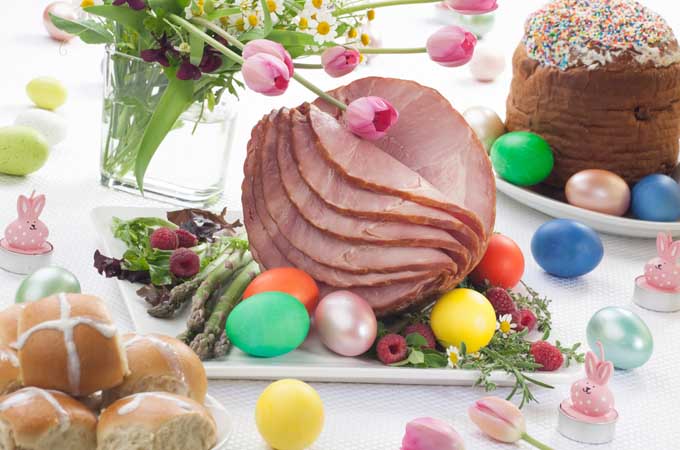
All my planning got me to thinking about why we eat the food we do at Easter, so I decided to do a little research into the topic.
Not surprisingly, considering that Easter is the most important Christian celebration of the church year (I mean, the resurrection of Christ is why Christians are even Christians, so of course it’s a really big deal!), most of the food commonly eaten on that Sunday is symbolic in the extreme.
I found all of my reading to be pretty interesting, and I thought many of you guys would feel the same way, so I decided to share some of what I found.
To make things even better, I have included a recipe for each of these traditional Easter menu items.
If one of these isn’t something you have ever made before, hopefully you’ll give it a shot this year (the last recipe is one I will be making with my kiddos for the first time myself this year).
Eggs
Hardboiled eggs are a common feature at Easter, especially when they’re used to make colorful dyed creations for decoration or Easter egg hunting.
As far as a menu item goes, deviled eggs are pretty common fare on your typical Easter table, and are one of my all-time favorites. The religious significance of eggs has pagan origins (as do most aspects of Christianity), and has always symbolized the coming of spring and the concept of new life or rebirth. Several pagan cultures (notably the ancient Egyptians, Persians, Phoenicians, and Hindus) actually believed that the world began as a giant egg.
With the advent of Christianity, the symbol of the egg took on a new meaning. On a literal level, the shell of the egg represented the tomb of Christ. The meat, meaning the egg itself, was a physical representation of the concept of new life in Christ. On a figurative level, the egg signifies the ability to achieve a spiritual rebirth.
Further, the traditionally strict fasting practices of early Christians all the way through to more modern times meant eggs were off limits during the 40 days of Lent. Hence, Easter Sunday would have been the first time eggs could be eaten since Shrove Tuesday (the day before Ash Wednesday, and the start of the Lenten season).
So, of course, eggs would make an appearance on the dinner table!
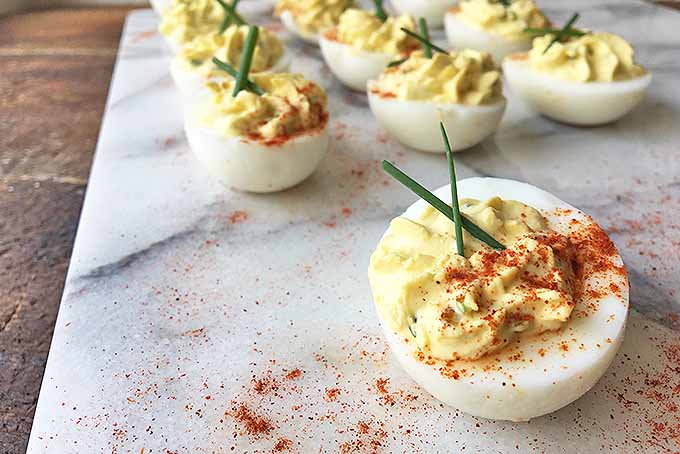
Of course, you can always use mayo yourself, or you could even substitute with plain Greek yogurt.
The mustard, salt, dill, and relish quantities are simple to adjust according to your tastes..
You can also substitute capers for the relish, and I’ve even had these made with finely diced green olives before. Chives in place of the fresh dill would be great, too.
Lamb
The tradition of having roasted lamb at this time of year goes back thousands of years to the time when the Israelites were held as slaves in Egypt.
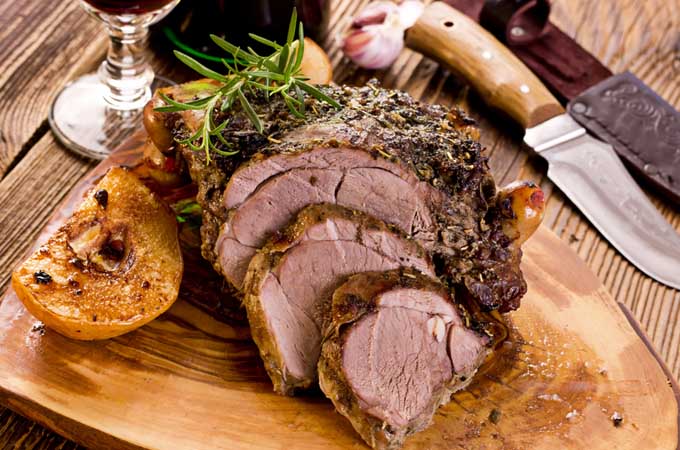
As retribution against the pharaoh for refusing to let his chosen ones go, God sent the Angel of Death to kill the firstborn of all the Egyptian households.
God told Moses to have the Israelites sacrifice one lamb per household and use the blood of each lamb to mark the doors of their houses to ensure that the Angel of Death would pass over (Passover, literally) their homes.
God instructed them to roast the sacrificial lambs and eat the meat with unleavened bread and bitter herbs, and, thus, the first Passover meal was born.
Fast forward many generations, and after the death and resurrection of Jesus, as many Jewish followers converted to the new religion of Christianity, they naturally brought their traditional Passover meal with them to be used as the feast meal to celebrate the end of the Lenten season and the resurrection day of Christ.
Christians were able to bring a new level of significance to lamb as a traditional Easter food as a representation of the willing self-sacrifice of the perfect Lamb of God, Jesus.

There are many ways you can serve lamb at your own Easter meal: lamb chops, the always-impressive rack of lamb, or even lamb kabobs if you’re into keeping things casual.
This lamb recipe makes a nice change of pace, and, if you prepare it the night before and let it marinate overnight, it cooks in just 30 minutes right on your grill.
- 6- pound boneless leg of lamb butterflied
- 1/2 cup red wine vinegar
- 1/2 cup olive oil
- 2 tablespoons fresh thyme
- 2 tablespoons fresh rosemary
- 1 tablespoon fresh oregano
- 3 cloves garlic peeled
- 1 tablespoon salt
- 1 teaspoon black pepper
- In the bowl of a food processor, combine vinegar, oil, thyme, rosemary, oregano, garlic, salt, and freshly ground pepper. Pulse until the garlic is very finely chopped and you have one cohesive mixture.
- Take a sharp knife or a fork and prick the lamb all over on both sides. Place the lamb in a large dish and pour the marinade over the meat. Leave in the fridge overnight, up to 24 hours.
- When you are ready to grill, pull the lamb out and let it come to room temperature. Then, get your grill ready. Leg of lamb is best grilled at a medium temperature over indirect heat. This is easy to achieve with a gas grill, but if you’re using charcoal, bed your charcoal over to one side and let it burn for about 10-15 minutes before you get grilling on the side with no charcoal.
- Grill the lamb for about 15 minutes per side, or until you reach the desired level of doneness.
Equipment Required:
Ham
In the United States, I think ham is much more common as the Easter dinner centerpiece than lamb is. There are three reasons for this, and the first is simple availability.
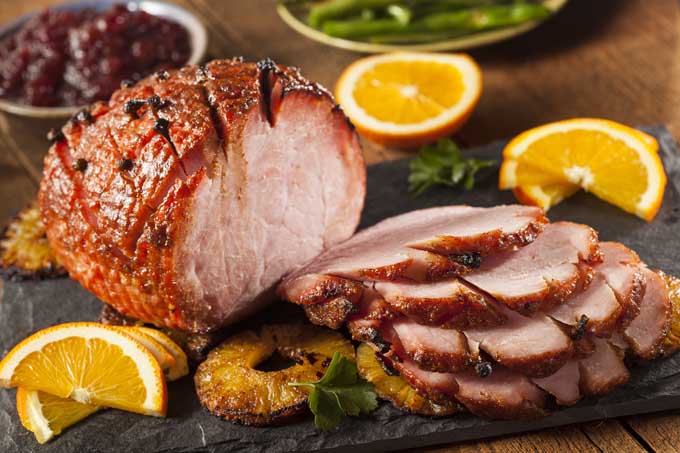
Back in the day, the pigs that farmers had fattened up over the summer were slaughtered in the late fall. What couldn’t be cooked and eaten right away was salted and cured to be eaten later.
The curing process took the whole winter, and usually the first cured ham was ready to be eaten right around Easter. So if you have this nice cured ham ready to go, why go to the trouble and expense of buying and cooking another kind of meat?
Secondly, going back to pre-Christianity, pigs have always been a symbol of luck and prosperity. In pagan times, it makes perfect sense that if you were celebrating the arrival of spring and the rebirth of the land, it makes complete sense to eat pork as a way to try and ensure a prosperous planting season and subsequent harvest.
Additionally, although Jewish Old Testament law prohibits the eating of pork, early Christian fathers wanted to ensure that all would feel welcome and having ham and other pork products on feast days would provide the sense of inclusion that was needed.
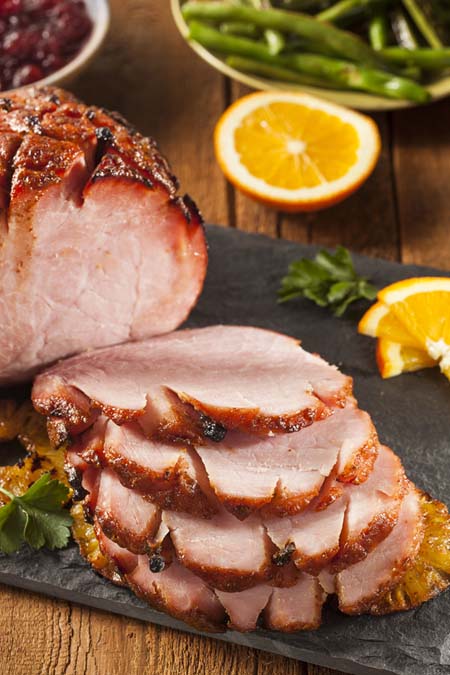
If you are in need of a high-quality ham to serve, consider buying one of the many options from Snake River Farms. The company’s Kurobuta ham selections are bred from a 100% Berkshire hog raised in a network of small family farms.
Now, personally I am not a huge fan of ham, especially when it is sweet, as with a honey-glazed ham or the like. I do like a good smoked ham, though, so this recipe is perfect for me.
I also love that the glaze has mustard and cider vinegar in it, so even with the brown sugar, it’s not overly sweet.
I like to cook this in a really nice roasting pan and serve it directly out of the pan – especially if we are doing a buffet style dinner.
- 12- pound smoked ham skinless and shankless
- 1 cup packed brown sugar
- 1/4 cup Dijon mustard
- 2 tablespoons apple cider vinegar
- Whole cloves for studding
- 1 can pineapple rings optional
- Place the smoked ham on a rack in a large roasting pan. Score the top of the ham into diamonds by making diagonal lines going one direction, and then repeat the process with the lines going the opposite direction.
- At each line intersection, insert a whole clove to stud the whole ham.
- Bake at 350 degrees for 1 ½ hours.
- In a small bowl, combine brown sugar, mustard, and vinegar. Remove ham from oven and spread the mustard mixture over the whole top of the ham. If you desire, you can place pineapple rings on top and around the ham for a little added citrus flavor.
- Return the ham to the oven and bake for an additional 35 minutes. Let rest for 10-20 minutes before slicing and serving. Garnish with orange slices and fresh herbs of your choice.
Hot Cross Buns and Other Sweet Breads
Hot cross buns are a traditional Good Friday treat going back to the time when Christianity first came to Great Britain.
Today, these sweet rolls are popular in Ireland, Australia, New Zealand, the Caribbean, South Africa, and Canada as well as in Great Britain.
They aren’t relegated just to Good Friday anymore, either. Mass supermarkets start carrying them in some places as early as January, and they are enjoyed all the way through Easter.

Early Christians in England started making hot cross buns to replace the small wheat cakes that the Anglo-Saxons baked in honor of the goddess of spring, Eostre (along with stealing her name to give a title to their own feast day).
The church substituted those cakes with these spiced, sweet breads that were blessed by the church and marked with the cross to further differentiate them.
The buns are traditionally made with currants, like blackcurrants, or raisins, but modern flavor variations include toffee, orange-cranberry, apple cinnamon, and chocolate.
Additionally, though the cross on top is typically made of shortcrust pastry (like a pie crust), you may also find the buns marked using frosting or some type of sugar glaze. You can make your own following Jennifer’s recipe.

Other countries have their own traditional Easter sweet breads that similarly served to replace pre-Christian traditions.
In Italy they have the dove-shaped colomba or an Easter egg bread, while Russia’s most famous Easter bread is the kulich.
While all these traditional breads have their place and are certainly delicious, this year I’m planning on making the much more contemporary bun called an Empty Tomb Roll that has strictly Christian origins and symbolism.

Empty Tomb Rolls: Get the Recipe Now
After reading the recipe below, you’ll see how this all comes together:
- The marshmallow in the center represents the body of Christ.
- The melted butter/cinnamon sugar coating could be seen as the linen in which Christ’s body was wrapped for burial.
- The crescent roll or biscuit dough signifies the tomb.
- After baking, the marshmallow magically evaporates (leaving behind it’s lovely sticky sweetness), a representation of the empty tomb on that third day.
I love how I can make this recipe with my kiddos and talk about the Easter story with them at the same time. I cannot wait to make these this Easter, and I hope you’ll give them a try as well!
And there you have it! These are the most commonly served Easter menu items, and I thought it was pretty neat delving into the history of all of them.
Of course, any spring vegetables you serve at the meal could signify new life/rebirth as well. We usually have asparagus on our table every Easter Sunday.
Looking for some table setting tips to set the atmosphere for your beautiful holiday spread? This post will get you started.
Hopefully, you guys found this as interesting as I did and maybe even came away with a new recipe to try this year.
About Ashley Martell
Ashley has enjoyed creative writing since she was six years old, when she wrote her first short story. She majored in English literature at the University of Montevallo. After years of professional work, she is now a stay-at-home mom of three, who uses her craft to write about her life and adventures in and out of the kitchen.

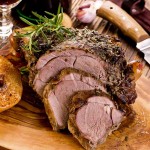
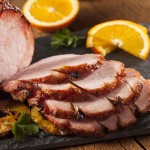
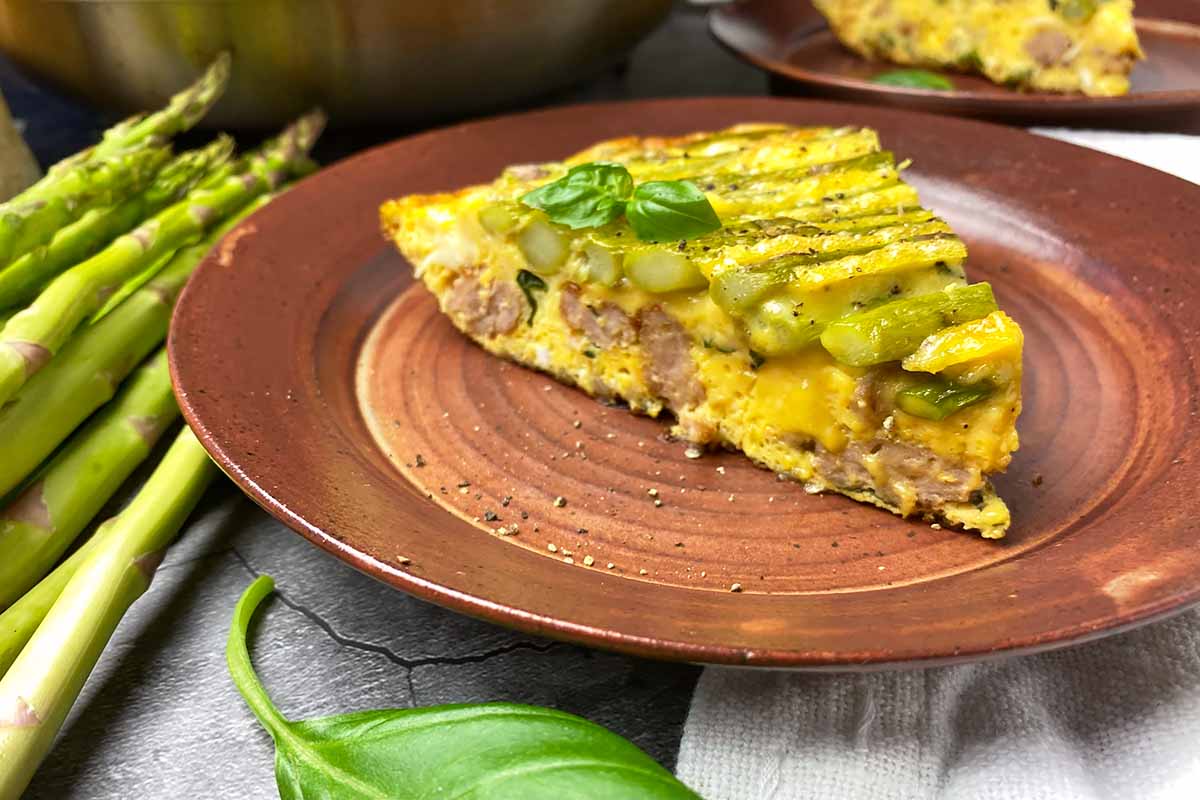

Those tomb rolls look like heaven (no pun intended, haha). One question though, how sweet would they be? I mean you have all that sweet from the marshmallows alone, and then you’re adding cinnamon sugar to it. Perhaps they’d go well with some hot coffee or milk for the kids?
I make a lot of boiled eggs and recipes with eggs every Easter! They go well in every mix and they taste so good with cooked lamb!
I also make a lot of cheese pastries. They are vital for me as the second dish after the lamb. Very tasty!
I’m cooking Easter dinner for 12 people this year. I wanted something special and different. Your deviled eggs, glazed smoked ham, empty tomb rolls, and a variety of the desserts on the site have just mad it to my Easter menu. And thank you for the history lesson! That was actually very interesting. I had no idea about any of the origins. I honestly believed the food was chosen because it tastes good and then it became tradition from there. Really, though, thank you!
These empty tomb rolls are something else! What a great way to teach the kids about the true meaning of Easter – through cooking! Being in the UK, I’ve never even heard of these before but I’ll be sharing this link with a friend from church who I bet would loke to make these with her kids. Thanks!
I never knew you could make deviled eggs without mayo. What a good idea to replace mayo with sour cream. I will definitely be trying these. I don’t like to waste the Easter eggs, so we usually make them into deviled eggs. Thanks for the tip.
That lamb looks lovely. Too bad my family prefers ham. I’d love to make that gorgeous lamb recipe.
I love learning the reasons behind how traditions came to be. Adding the history to food only makes be double happy. Thanks for the information on how eggs have taken over Easter like Gremlins!
These are all really great, but what I’d really like to find is a way to make ham without adding anything sweet. I’ve always used a brown sugar glaze or pineapple rings with cherries in the center on top of a glaze, but with so many other sweets, I’d love to find another way.
I usually make yeast rolls instead of sweet breads, so I’m covered there (even those all look really good).
The ham and the no may deviled eggs look delicious. The deviled eggs are definitely going to make an appearance at my table this Easter. They look perfect. I love the idea of substituting the mayo with sour cream. It’s so simple and yet it never occurred to me to do it.
The deviled eggs got me interested…how about making a cohesive yellow egg yolk mess in the kitchen but in the end make them look extremely delicious…its making me believe, one can make art out of anything 😉 … everything looks scrumptious… as for the empty tomb rolls… can i make mine a little bitty colorful…some colored vermicelli perhaps?…just asking {shoulders shrugged}
In Eastern Europe Easter is mostly about the ham
Our parents start to talk about it after Christmas, how to prepare, where to buy, etc. Then talk about it for months and months, on and on.
You should see the ham, I bought … I am gonna prepare it slowly … – they say. Then the fights about whether the
eggs should be cooked with the ham or separately.
I swear we should call spring ham-season instead. And when it finally finishes and the last leftover piece of ham is consumed somewhere around the beginning of May, they say: We should cook ham this and that way next year 🙂
Since I’m originally from Greece, the land of good food, I can say that this post made my hungry tummy growl, haha! My favorite Easter treat has to be lamb that’s been grilled outside, but it’s something that’s hard to cook when you live in the central area of the city. Eggs with fillings are so easy to make and most of the people enjoy eating them (even kids!) which means that they’re just perfect to serve before a heavy dinner. Also ham is a family favorite, especially if it’s slowly cooked.
Thanks for the post! It was nice to read your tips.
The dishes look delicious! I will have to try your deviled eggs recipe.
In our country it is a custom to make Pasca, a braided pie with cottage cheese filling. It’s very good.
We also make lamb tripe and lamb steak. The lamb is the centerpiece of an Easter dinner.
I am not a big fan of lamb meat, I don’t like it’s taste, that’s why I also add pork organs to the lamb tripe.
Happy Easter!
luv easter lol
luv easter 2